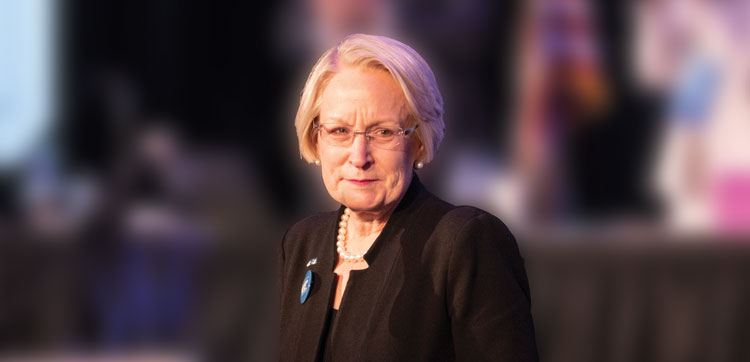How the ABA has adjusted to the COVID-19 pandemic

Illustration by Sara Wadford/Shutterstock
In mid-March, as COVID-19 showed no signs of slowing down, the American Bar Association put its plan for pushing through the pandemic into action.
“First, we needed to make sure we did our best to ensure the safety and health of employees and volunteers,” ABA President Judy Perry Martinez says. “That was the primary focus.”
By March 12, the ABA had rescheduled or canceled the in-person portions of nearly a dozen major events, including ABA Day, the annual lobbying effort that draws hundreds of members to Capitol Hill. By the following week, 98% of staff was working remotely, a measure that ABA Executive Director Jack Rives says was anticipated and planned for by the association.
“We had practiced various scenarios, including a pandemic,” he says. “We had good plans, and we were able to implement them. Our staff was prepared, and we found that we could transition to a remote working environment en masse.”
In addition to changes in ABA operations, Martinez says association leaders realized they had an opportunity to be “out front with regard to looking at the legal needs and responding to them.” For Martinez, who is of counsel with Simon, Peragine, Smith & Redfearn in New Orleans, it paralleled her experience after Hurricane Katrina hit the Gulf Coast in August 2005.
“It brought forth new emerging challenges and needs that people were experiencing, but also when the waters receded, it exposed societal problems and challenges—many of which have legal solutions—that had not been addressed,” she says. “And so it is incumbent upon on us as the American Bar Association to make sure we immediately focus our attention on that as well as on the needs of our members.”
Being of service
The ABA launched its Task Force on Legal Needs Arising Out of the 2020 Pandemic on March 13 to address legal challenges facing Americans during the public health crisis and make recommendations on how to overcome those challenges.
The task force is chaired by James Sandman, the former president of the Legal Services Corp., the largest funder of civil legal aid to low-income Americans. It includes representatives from ABA entities and leaders from other organizations, including the Conference of Chief Justices and the National Center for State Courts.
It also seeks to mobilize a larger network of pro bono attorneys. “We need a call to action like we have never needed before in order to address what we know will be a surge in legal needs in the months and years ahead,” Martinez says. “We are calling upon lawyers across the country in what we know are challenging times for them in their practices, as well as in their obligations to their families and their communities, to step up and serve.”
The task force’s website includes more information about pro bono efforts and resources related to remote service delivery, court closings and rule changes in addition to current legal issues related to COVID-19.
The ABA’s ongoing pro bono initiatives include ABA Free Legal Answers, a virtual clinic that connects volunteer attorneys to income-eligible users with specific civil legal questions, and the new Disaster Relief Pro Bono Portal. The Young Lawyers Division’s Disaster Legal Services Program and Paladin, a justice technology company, introduced the portal in April to provide more opportunities to attorneys who want to help people impacted by COVID-19 and other disasters.
On May 13, the ABA announced the complementary Coordinating Group on Practice Forward, which aims to help members identify both challenges and opportunities now facing the legal profession and justice system.
Bill Bay is the chair of the House of Delegates until the close of the 2020 ABA Annual Meeting, and he is a partner with Thompson Coburn in St. Louis. Bay and Laura Farber, a partner with Hahn & Hahn in Pasadena, California, co-chair the group. Through August 2021, it will distribute existing ABA resources, including seminars and publications, as well as work with ABA entities and state, local and affinity bar associations to provide additional information on how to best practice law.
The group also plans to work with experts in social psychology, health, economics and technology.

ABA President Judy Perry Martinez says, “We need a call to action like we have never needed before in order to address what we know will be a surge in legal needs in the months and years ahead.” Photo by Mitch Higgins/ABA Media Relations
“We want to bring in expertise, whether it’s someone in the ABA or outside of the ABA, to help understand what we don’t know yet about how the legal profession is being transformed at this moment as a result of the pandemic—and how we make sure we come out of this stronger,” Martinez says.
Several other ABA entities, including the Section of Civil Rights and Social Justice, have responded to COVID-19 by offering webinars that explore how the pandemic underscores critical legal issues. The Business Law Section, Health Law Section and Solo, Small Firm and General Practice Division are also among those that have collected COVID-19 resources and provided them to members.
In addition to other efforts, the Commission on Law and Aging published a “special coronavirus edition” of its journal Bifocal in May, and the Commission on Lawyer Assistance Programs created a list of mental health resources to help judges, attorneys and law students prioritize their well-being during the pandemic.
Meeting needs
By mid-June, the ABA had either canceled or rescheduled nearly 100 in-person meetings.
The ABA’s executive director explains that this significantly impacted the association, and as a result of lower revenue projections, the ABA now needs to cut $9 million from the general operations budget for fiscal year 2021. The Board of Governors is expected to approve the budget at the ABA Annual Meeting, but Rives adds that member services should not be affected.
“We know it is critical to provide good value to our members, and across the board, I do not believe that members will see much, if any, impact in the aspects of membership they value,” he says. “That is something we have been very carefully analyzing as we considered reductions in our expenses.”
Rather than canceling, several of the ABA’s spring and summer events went entirely virtual for the first time. This included ABA Day in April and Law Day in May. The 2020 ABA Annual Meeting, scheduled to take place from July 29 to Aug. 4, will also be held virtually (ambar.org/annual).
Brian Henry, chair of the Antitrust Law Section, says plans for its spring meeting were altered “when it became clear that even if we had the meeting, no one would be there.”
From April 17 through May 1, the section hosted more than 30 free events, including a livestreamed keynote presentation and virtual receptions. It used the website that hosts the section’s Our Curious Amalgam podcast and released new podcast episodes and videos each day.
“There are very high standards for our in-person spring meeting, and the trick was taking those high standards and applying them online,” says Henry, vice president and senior managing counsel at the Coca-Cola Co. in Atlanta. “We agreed that if we’re going to do this, we have to make it as professional as in-person, as springlike as possible.”
Henry says the virtual spring meeting exceeded expectations, drawing more than 12,000 visits. Plus, he adds, those numbers will increase as people continue to access content still available online.
The Real Property, Trust and Estate Law Section also offered its National CLE Conference virtually. Chair Jo-Ann Marzullo says the section reduced the registration fee; offered 35 live programs on May 14 and 15; and then made those programs available on demand for two years.
“We thought, ‘Let’s use this to promote why people should care about the ABA, and get to those who have never been exposed to RPTE,’” says Marzullo, an attorney in the Boston office of Ligris + Associates. “Maybe we could draw in people who have never come to the physical meeting. That’s where we were trying to see the rainbow in this.”
Like Henry, Marzullo considers the virtual conference a success. Not only did she receive positive feedback, but it attracted 428 paid registrants—the highest number in recent years.
“This, everyone was excited about; and I believe staff is already working on how we could make it better in the future,” she says. “Someone had to go out first and make it happen, and I am delighted and overjoyed by how well it really went.”
For more coverage of COVID-19, go to ABAJournal.com/covid-19. This story was originally published in the August-September 2020 issue of the ABA Journal under the headline: “Rapid Response.”



